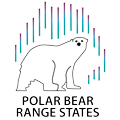Manage human-bear interactions to ensure human safety and to minimize polar bear injury or mortality
This webpage is under construction
- Objective Leads:
- Actions associated with Objective-5 in the 2023-2025 Implmentation Plan
- Implementation approach
- Polar Bear threats linked to Objective:
- Expected impact/ outcome of the Objective-5 workplan:
- How the progress toward Objective-5 will be evaluated:
- Liaison with other CAP-Objectives:
- Liaison with external bodies
- Expected dissemination of Deliverables and Outcome to stakeholders
- Potential Challenges and how they will be addressed (mitigation actions) [1]:
Objective Leads:
TBD
Actions associated with Objective-5 in the 2023-2025 Implmentation Plan
(see top-left sidebar for further information on the actions)
HBC-A5: Report findings on human-bear conflicts which end in injury or death (to bears or humans) annually on the RS website for each country or subpopulation
HBC-A8: Template for site specific conflict mitigation plans
Implementation approach
TBD
Polar Bear threats linked to Objective:
Levels of the Threats: Medium
Expected impact/ outcome of the Objective-5 workplan:
The short-term impact of this objective is to provide a common understanding on the level and location of polar bear – human interactions and safety risks associated with such interactions through a standardized data collection approach and reporting. In the short- and medium-term, the public will be able to access the recommended best management practices to address increased bear -human interactions safely and to prevent an escalation of conflict. In the long-term, these actions will provide the possibility to reduce bear-human interactions and negative outcomes to a level that does not threaten the long-term survival of polar bears driven by this possible threat.
How the progress toward Objective-5 will be evaluated:
Performance metric-1: Change in the number of bears injured or killed in conflict situations and in the number of humans injured or killed by bears, compared to the baseline. (see PBRS website)
|
Performance metrics |
Baseline in 2020 |
Status by May 2023 |
Expected status by 2025 |
|
Indicator-1: |
58 |
2021: 62 1) 2022: 50 2) |
Predicted to increase |
|
Indicator-2: |
3 |
2021: 2 1) 2022: 3 1) |
Predicted to increase |
|
Indicator-3: |
No data collection taking place according to established PBHIMS format |
No data collection taking place according to established PBHIMS format |
TBD |
1) Data from Russia not included
2) Data from Russia not included; Data provided by Canada is preliminary
3) Performance indicator 3 is not currently reported in all locations; however the required data are included in the minimum standards guidance agreed upon by the Range States. Several Range States have or are in the process of establishing systematic collection of the required information in remote communities and other locations where logistical or other challenges exist
Liaison with other CAP-Objectives:
Objective 1: Track and reduce emerging threats to polar bears – possibility of emerging threats that may bring with them increasing conflict level.
Objective-2: TBD
Liaison with external bodies
(i.e. organizations, communities, stakeholders, expert groups, etc.):
TBD
Expected dissemination of Deliverables and Outcome to stakeholders
(public, policy makers, legislators etc.):
Information will mainly be made available to the public and to the Range States through the Range States website.
Potential Challenges and how they will be addressed (mitigation actions) [1]:
Lack of involvement from all Range States is a potentially severe challenge for several of the actions (specifically A3, A4 and A5 – baselines and reporting of performance metrics) that require involvement from all Range States. Likelihood (4) x Negative impact (5) = 20.
Additionally, securing sufficient stakeholder involvement and making sure the work in Objective 5 makes a difference "on the ground". The CWG also faces the challenge of having high member participation to remain an active and relevant forum for information sharing and collaboration on all aspects of conflict, as the need arises.
That output from the group is adapted by stakeholders, circulated and put to use in or by the Range States, is also a critical step for the work under Objective 5 to have real impact and to achieve the wanted outcome. Likelihood 3 x Negative impact (5) = 15
[1] The level of challenge may be estimated by multiplying the level of likelihood (scale 1-5) by the negative impact it may have (scale 1-5). Minor: 1-10, Moderate: 11-15; Severe: 16-25.
